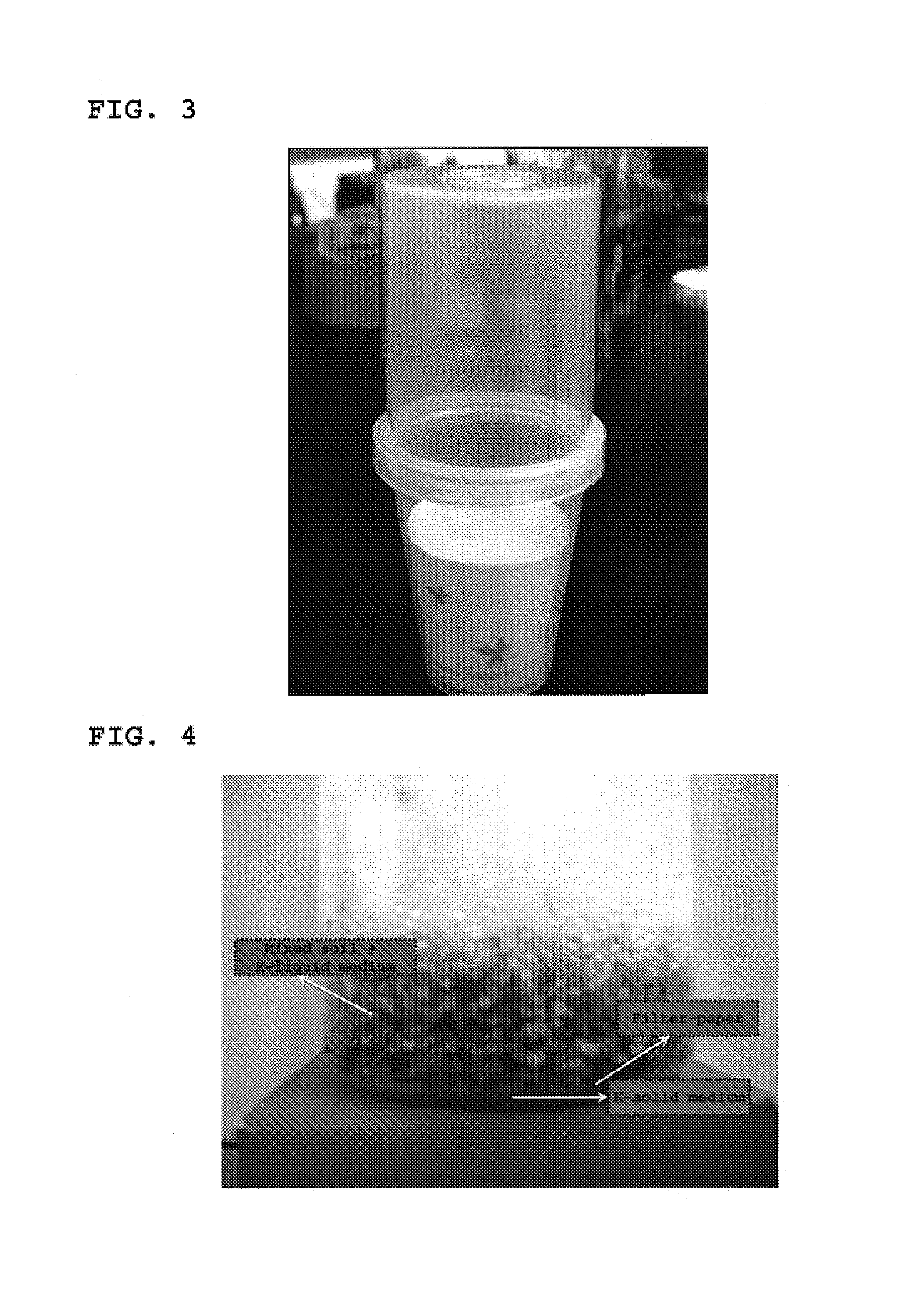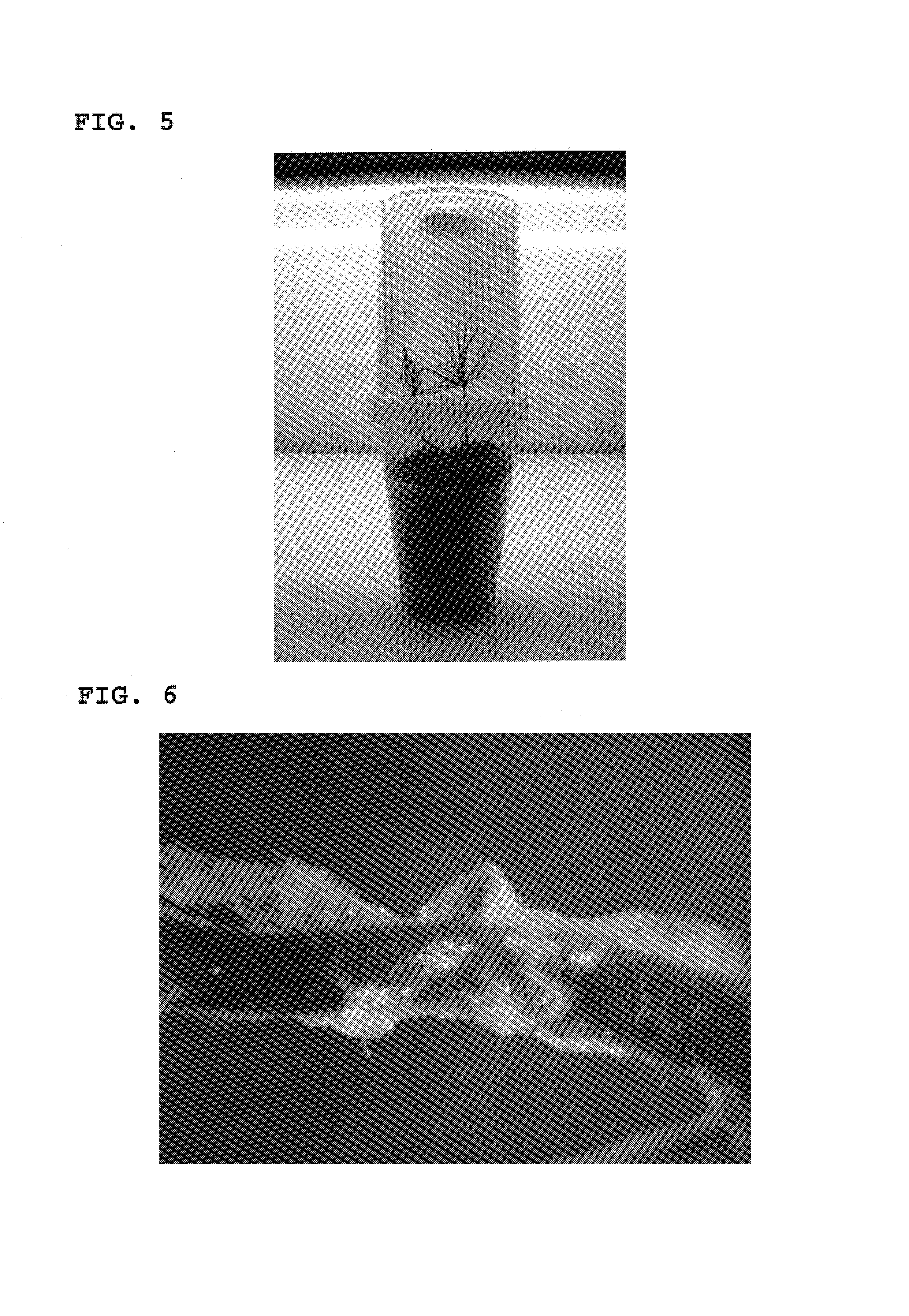Method of preparing Tricholoma matsutake-infected young pine by coculturing aseptic pine seedlings and T. matsutake
a technology of tricholoma matsutake and aseptic pine, which is applied in the field of preparation of tricholoma matsutakeinfected young pine trees, can solve the problems of inability to form fruit bodies (mushrooms) of i>t. matsutake/i>fungus in vitro, and the inability to detect the presence of ectomycorrhizal fungus in the in vitro,
- Summary
- Abstract
- Description
- Claims
- Application Information
AI Technical Summary
Benefits of technology
Problems solved by technology
Method used
Image
Examples
example 1
Production of T. Matsutake-infected Young Pine Trees Using a Culture Container for a Fungus Flammulina Velutipes
[0047]In order to obtain T. matsutake-infected young pine trees, as shown in FIG. 4, sterilized K-solid medium was poured into a sterilized culture container generally used for cultivation of the mushroom Flammulina velutipes, and allowed to harden. After covering the K-solid medium with a filter paper, mycelia from liquid-cultured fruit bodies of T. matsutake KBFERI 20T05 were inoculated onto the filter paper at an amount of 0.075 mg dry weight with 5 ml of sterile water. A mixture of perlite and sphagnum peatmoss at a ratio of 80:1.5 was added onto the inoculated fungal mycelia, and K-liquid medium of pH 5.6 was added into the soil, thus giving the infection medium. Then, seedlings obtained by aseptically germinating pine seeds were planted onto the infection medium containing the mixed soil and K-liquid medium, and the culture container was covered with a lid, followed...
preparational example 1
Preparation of an Inoculum from Liquid-cultured T. Matsutake
[0051]A fungus T. matsutake used as an inoculum in the present invention was isolated from a naturally occurring matsutake mushroom, which was, right before its cap opened, collected from 10 ha of the Doyoo forest located in Namsan-dong Gyeongju-si Gyeongsangbuk-do, Korea. From the collected mushroom, the section between the cap and the gills was cut into pieces of 0.5 mm in size within 8 hrs after collection, and planted onto MMN medium of pH 5.5 prepared according to the composition shown in Table 2, below. Then, the isolated mycelia were further incubated in PDA medium at an optimal temperature for mycelial growth of T. matsutake, 23±0.5° C., for 60 days. T. matsutake fungus was successfully isolated from about 98% of the cultured mycelia. The isolated mycelia were found to have over 99% homology with a known T. matsutake fungus in ITS sequence and DNA sequences of whole 5.8S rRNA and a portion of 18S. The identified rD...
preparational example 2
Preparation of Infection Medium Using Mixed Soil and K-liquid Medium
[0054]As bed soil to cultivate pine seedlings, perlite and sphagnum peatmoss were employed. After being mixed at a ratio of 80:1.5, they were sterilized in a container. On a clean bench, the sterilized mixed soil was poured into the T. matsutake mycelia-inoculated culture container up to a suitable height.
[0055]K-liquid medium was prepared according to the composition shown in Table 1, above. After being autoclaved at a high temperature. 100 ml of K-liquid medium was poured onto the mixed soil on a clean bench.
PUM
| Property | Measurement | Unit |
|---|---|---|
| length | aaaaa | aaaaa |
| thickness | aaaaa | aaaaa |
| pressure | aaaaa | aaaaa |
Abstract
Description
Claims
Application Information
 Login to View More
Login to View More - R&D
- Intellectual Property
- Life Sciences
- Materials
- Tech Scout
- Unparalleled Data Quality
- Higher Quality Content
- 60% Fewer Hallucinations
Browse by: Latest US Patents, China's latest patents, Technical Efficacy Thesaurus, Application Domain, Technology Topic, Popular Technical Reports.
© 2025 PatSnap. All rights reserved.Legal|Privacy policy|Modern Slavery Act Transparency Statement|Sitemap|About US| Contact US: help@patsnap.com



